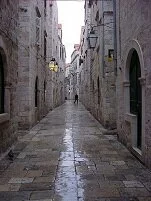Architecture of Croatia

Venetian-styled Dubrovnik
Croatia's oldest still standing architecture is from the Roman times. The two best examples from this time are the Pula Arena in Pula and Diocletian's Palace in Split. The arena was built in about year 0, while the palace was built about 300 years later. The palace however has mostly been destroyed, however many walls and buildings still remain. Over time new buildings have been put up in the space, including structures in Romanesque, Renaissance, and Baroque styles.
Through the next millennium most of the architecture introduced in Croatia was church architecture or fortifications, primarily consisting of stone and Romanesque structures. The Euphrasian Basilica in Porec is a great example of early Christian (300s) church architecture as are many of the churches and buildings in Trogir.
The crown jewel of Croatia is the city of Dubrovnik and its beginnings as a sea power date to the 1200s when Gothic architecture was common in Croatia. Much of the city's architecture is from this time period (although it has been reconstructed since the Balkan Wars), however today many of the buildings have Renaissance or Baroque facades along with a couple churches in each of these styles.